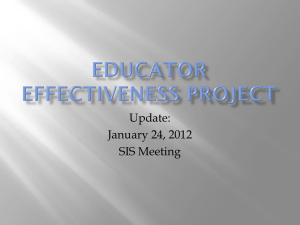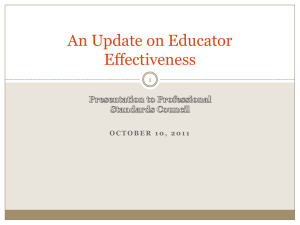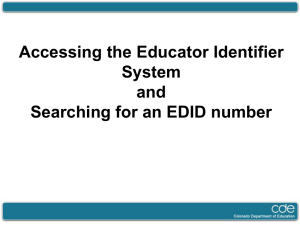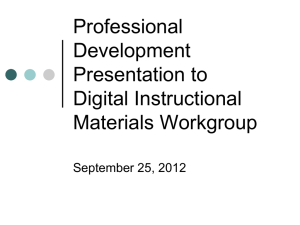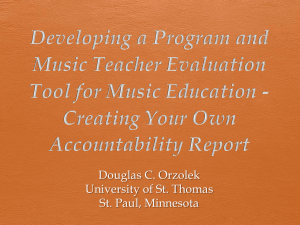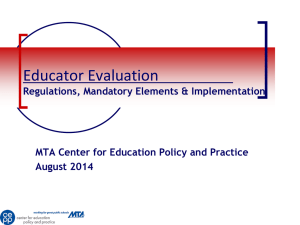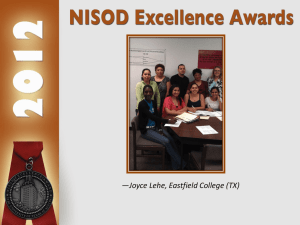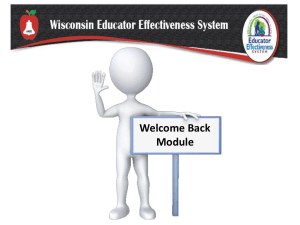Measuring Educator Effectiveness
advertisement
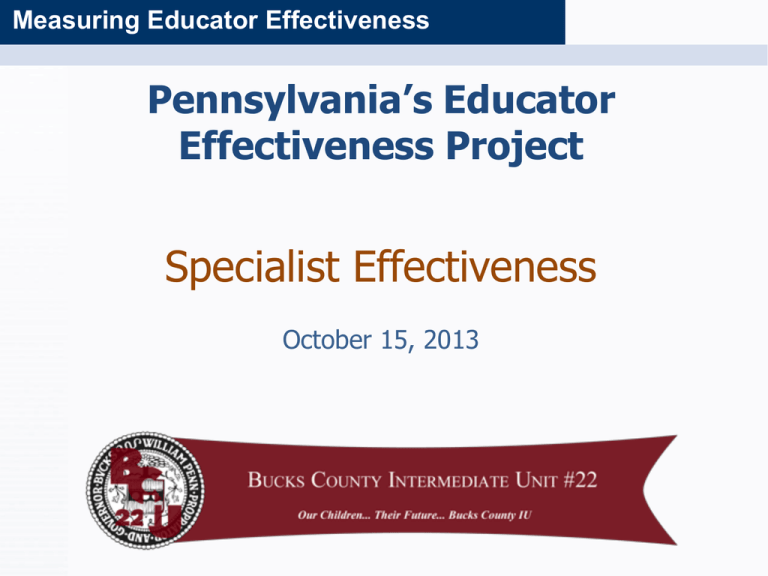
Measuring Educator Effectiveness Pennsylvania’s Educator Effectiveness Project Specialist Effectiveness October 15, 2013 Measuring Educator Effectiveness Agenda • • • • Prior knowledge Act 82 The Framework The Rubrics Measuring Educator Effectiveness What do you know? • • • • Define good instruction. Think…What do you know about Act 82. Pair…What does a partner think? Share…What are the generalizations. Measuring Educator Effectiveness Act 82 – June 30, 2012 requires… • Multiple Measures of Teacher Effectiveness – 2013-14 – Observation/Evidence (50%) – Student Achievement (50%) • Multiple Measures of Non-Teaching Professional Employee Effectiveness – 2014-15 – Observation/Evidence (80%) – Student Performance (20%) • Multiple Measures of Principal Effectiveness – 2014-15 – Observation/Evidence (50%) – Student Performance (50%) Measuring Educator Effectiveness School District Teachers Without Eligible PVAAS Score Observation/Evidence Building Level Data Danielson Framework Domains 1. Planning and Preparation 2. Classroom Environment 3. Instruction 4. Professional Responsibilities Indicators of Academic Achievement Indicators of Closing the Achievement Gap, All Students Indicators of Closing the Achievement Gap, Subgroups Academic Growth PVAAS Other Academic Indicators Effective 2013-2014 Observation/ Evidence, 50% Effective 2013-2014 SY Building Level Data, 15% Elective Data/SLOs Elective Data, 35% Optional 2013-2014 SY Effective 2014-2015 SY District Designed Measures and Examinations Nationally Recognized Standardized Tests Industry Certification Examinations Student Projects Pursuant to Local Requirements Student Portfolios Pursuant to Local Requirements Measuring Educator Effectiveness School District Teacher Rating in 2013-14 School Building Data Observation/Evidence Effective 2013-2014 SY Danielson Framework Domains 1. Planning and Preparation 2. Classroom Environment 3. Instruction 4. Professional Responsibilities Effective 2013-2014 SY Indicators of Academic Achievement Indicators of Closing the Achievement Gap, All Students Indicators of Closing the Achievement Gap, Subgroups Academic Growth PVAAS Other Academic Indicators Credit for Advanced Achievement School Building Data, 15% Observation/ Evidence, 85% Measuring Educator Effectiveness The Framework • Create a T chart. • Name the four domains. • Identify the 22 components. Measuring Educator Effectiveness Specialist Effectiveness Educational Specialists Licensed Professionals Measuring Educator Effectiveness Non-Teaching Professional Employee Effectiveness beginning in 2014-15 • Educational Specialists • Licensed Professionals – local decision • Individuals working under instructional certifications who do not provide direct instruction to students 19 Measuring Educator Effectiveness Educational Specialists • • • Educational Specialists are defined in Pennsylvania School Code with the scope of their certificates and assignments described in Certification and Staffing Polices and Guidelines (CSPGs). Currently CSPG 75 through 81 list the following specialist certifications: – Dental Hygienist – Elementary School Counselor – Home and School Visitor – Instructional Technology Specialist – Secondary School Counselor – School Nurse – School Psychologist PDE is in the process of working with stakeholder groups from across the Commonwealth to revise the Danielson Framework for Teaching to reflect the specific roles and functions of the identified specialist groups Measuring Educator Effectiveness Licensed Professionals • Given that many LEAs hire licensed professionals under teacher contracts who are not certificated as specialists under Pennsylvania School Code, PDE has made a decision to develop revised Danielson Framework for Teaching rubrics for the following roles: – Occupational Therapist – Physical Therapist – Social Workers – Behavior Analysts – Educational Interpreters • PDE is in the process of working with stakeholder groups from across the Commonwealth to revise the Danielson Framework for Teaching to reflect the specific roles and functions of the identified licensed professionals. Measuring Educator Effectiveness Individuals working under instructional certifications who do not provide direct instruction to students • PDE has made the determination to classify individuals working under instructional certifications who do not provide direct instruction to students as non-teaching professionals as defined in Act 82. Given that they are working under an instructional certification they will be evaluated utilizing the Framework for Teaching. However, the observation component will constitute 80% and the multiple measures component will be 20% of professional’s evaluation. Additionally, they will not be evaluated under Act 82 until the fall of 2014. • Examples – IU TAC hired under a teacher contract – IU Consultants hired under a teacher contract – Instructional/Curriculum coaches – Special education case-managers – Program Coordinators – Itinerant Teachers Measuring Educator Effectiveness Specialist Effectiveness Educational Specialists Licensed Professionals Measuring Educator Effectiveness Non-Teaching Professional Employee Rating in 2014-15 Observation/Evidence Effective 2014-2015 Danielson Framework Domains 1. Planning and Preparation 2. Classroom Environment 3. Instruction 4. Professional Responsibilities Elective Data/SLOs Effective 2014-2015 SY Elective Data, 20% Observation/ Evidence, 80% IU Designed Measures and Examinations Nationally Recognized Standardized Tests Industry Certification Examinations Student Projects Pursuant to Local Requirements Student Portfolios Pursuant to Local Requirements Measuring Educator Effectiveness What Leads to Teacher Growth (and student achievement)? Coaching or Rating? Measuring Educator Effectiveness Danielson Framework 7 Measuring Educator Effectiveness Danielson Framework, Domain 3: Service Delivery Measuring Educator Effectiveness Unpacking the Rubrics • Examine your assigned rubric. • Examine the four performance levels. • What are the characteristics of this performance level? Measuring Educator Effectiveness Multiple Measures of Teacher Effectiveness – Observation/Evidence • Classroom observations by Principal/Supervisor, including evidence that demonstrates behaviors associated with improving student achievement: – Planning and preparation, including selecting standards-based lesson goals and designing effective instruction and assessment; – Environment, including establishing a culture for learning and appropriate classroom management techniques that maximize instructional time; – Service Delivery, including the use of research-based strategies which engage students in meaningful learning and utilize assessment results to make decisions abut student needs; and – Professional Development, including using systems for managing student data and communicating with student families Measuring Educator Effectiveness Professional Development for Teachers – Teachscape Teacher Effectiveness Series is available to registered users of the PDE SAS Portal. – Online training and 2 Act 48 hours – PDE Non Teaching Professionals Page – Standards Aligned Systems • http://www.pdesas.org/Instruction/Frameworks
